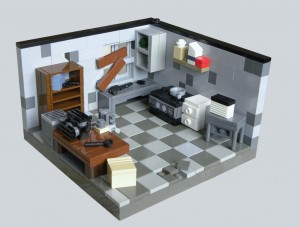 NTRODUCTION
NTRODUCTION
The basic premise behind buying apartment buildings is Stable Passive Cash Flow. Passive cash flow is a function of your unit being easy to rent, staying rented for a long time, and being easy to manage – these three conditions are required to achieve any type of passivity of cash flow.
If you’ve been reading my articles here and BiggerPockets blog for a while, you know that the concept of desirability is of utmost importance to me, both as it relates to my product being desirable to potential tenants, as well as to me. Stable passive cash flow to me is a function of my apartments being desirable to a wide cross-section of population, as well as being easy and as inexpensive as possible to manage, and this is nowhere more true than inside the kitchen. As such, remodeling an apartment kitchen is very much a balancing act…
As they are walking though the unit, your potential renters will be evaluating it against your competition in many different categories. Assuming the same general location, the top 5 items on their list will be:
- Kitchen
- Bathroom(s)
- Bedroom Sizes
- Overall Condition
- Presence of Covered Parking
Yes, the kitchen is at the top of this list. You’ve heard it said many times and it is absolutely true:
Kitchens Sell Units – period!
Trust me – if you get the kitchen right people will forgive you many other shortcomings of your unit, so pay attention!
FUNCTIONAL OBSOLESCENCE
I must preface further discussion by acknowledging that not everything is fixable and not every kitchen can be made into a desirable space – of course I am talking about functional obsolescence. Here we are not talking about how to remodel an apartment kitchen in order to make it more attractive and functional, but whether or not it is even possible:
Yes indeed, at times the problem simply can not be addressed structurally, and at time even though the issue is fixable, it would simply cost prohibitively too much. A space like this is dead in the water and should be avoided.
One example is a tiny galley-style kitchen whereby opening the refrigerator door blocks off the entire kitchen – you know what I am talking about; you’ve seen those. Now tell me, how are you supposed to make that feel attractive and functional, let alone sexy? This defines precisely what majority of tenants don’t want. Sure, if you are renting to students who wouldn’t know the business end of a butcher knife you can get away with it, but not if you’ll be renting to people for whom your unit will be HOME, and we want people to be comfortable in their HOME so that they don’t feel a need to go someplace else – get it? This is the stable part in Stable Passive Cash Flow.
Indeed, there must be reasonable amount of space in the kitchen! The kitchen doesn’t have to be huge, but neither can it be one of those galley-style kitchens so prevalent in apartments from a certain era, in which opening the refrigerator door blocks the entire kitchen.
Another example is a kitchen without day-light. In an apartment setting this problem is almost impossible to rectify, however, most of us spend considerable time in our kitchens and day light is a very desirable feature indeed.
Yet another example of functional obsolescence is no dishwasher and no room to install a dishwasher. Now you tell me – how are you supposed to attract the kind of tenant who will pay, stay for a long time, and take care of your unit if you can’t provide a simple thing like a dishwasher to them in 2014? Some things just are, and one of those things is that a unit should have a dishwasher, but more about this later…
OVERRIDING DISTINCTION TO REMEMBER
The distinction I need to make about apartments in general and apartment kitchens in specific is that things don’t necessarily have to be new in most cases, but they must be clean, they must look good, and they must function well. This goes for kitchens, bathrooms, flooring, and paint, etc.
REMODELING AN APARTMENT KITCHEN
And now let’s move onto the specifics of how to remodel an apartment kitchen. The easiest way to handle this discussion, in my opinion, is to outline some of the deficient (undesirable) elements that you will likely run into, and then to present some of the options relative to remedying these problems.
Keep in mind that remodeling a rental kitchen to bring it into the sphere of desirability will require one of three levels of work, depending on what you’ve bought:
- Clean-up
- Facelift Remodel
- Complete Gut
I am not going to spend much time discussing either the first or the third options, because you are not likely to need to do either. Here’s the thing – light clean-up presumes that you’ve bought a building in rather excellent condition; how often does that happen, and how likely are you to be able to negotiate a price and terms that make sense if this is the case? Indeed, you will almost always need to do more than a light clean-up. But on the other hand, if a complete gut of the kitchen is needed, it’s safe to assume that the rest of the mechanicals in the building are trashed as well. This is potentially a huge job and not something that a beginner like you needs to be involved in. Thus, most of the time you’ll be doing more than just a clean-up, but less than a total gut – you’ll be doing a facelift remodel, which is what we are going to focus on in this article.
But remember – at the end of the day your unit has to be able to attract the kind of tenants who have options – this is key. So, what does that take exactly…?
KITCHEN CABINETS
Relative to kitchen cabinetry you will likely encounter one of three problematic issues – metal cabinets, wood veneer that’s rotted out and falling apart, or laminated particle wood cabinets. Let’s talk about all three:
It is rather unbelievable that in the 21st century we can still find metal kitchen cabinets in apartments from time to time, but they are definitely out there and there is nothing attractive about them. Here’s the thing – 99 out of 100 people considering your mid-priced apartment will not accept metal cabinets as satisfactory, and unfortunately there’s just no easy way to convert metal into wood. Even if you paint them, which could get them to look OK, at the end of the day they are still 50-year old metal cabinets, and the kind of tenant who’s got options simply would not settle for this in 2014. Therefore, unfortunately you will need to replace those.
The same can be said about rotted out wooden cabinetry that is falling apart with drawers falling out and doors hanging – this is not something that can remain. While some of these problems can be remedied fairly easily and cost-effectively, and we will discuss that in a bit, should the actual cabinet boxes are rotted out beyond reason, you are also looking at a complete kitchen remodel. The kind of a tenant you want – a tenant who has a job and income, and therefore options, is simply not going to put up with dysfunction of this type in their kitchen.
Depending on the size of the kitchen, you can expect to easily spend $2,500 – $4,000 on labor and materials to replace cabinetry, and that’s if you go with descent but “nothing fancy” cabinetry. While you will do better if you shop at a wholesaler or buy in bulk, you can see that this is definitely a costly proposition. And this being said, this cost needs to be reflected in a substantive way in the discounted purchase price of the building, or else you simply need to pass on the opportunity. This kind of remodel falls into the complete gut territory…
On the other hand, if the wood cabinets are in good shape, you have several options. If the cabinets are varnished, and the varnish is in good condition, all you may need to do is work the doors and drawer faces with some cleaner/polish such as Orange or Old English. If they are scratched up beyond repair, however, then you will have a choice of either sanding and re-varnishing or painting.
Personally, I much prefer painting cabinets white because this tends to add to the over-all feeling of lightness and newness, and makes the kitchen feel bigger, which is a big plus in many apartment kitchens. Also, and this is an important consideration in an apartment kitchen, touching-up stains and scratches between tenants is easier on a pained surface rather than stained. Over to the right is an example of the end result of painted kitchen cabinets:
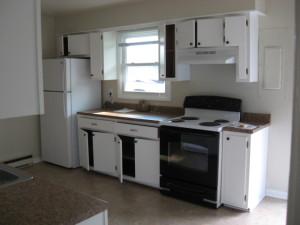
I use a good quality (thick) white exterior paint in a semi-gloss finish. The reason I use exterior paint is because it tends to be thicker and more durable than interior, which means that it washes better between tenants. The semi-gloss finish has just enough “pop” to it to give the cabinets that schick look, but it is not so extremely shiny as to pronounce all of the imperfections in the wood.
In a mid-priced unit, which is what we are discussing here, I do not typically paint the inside of the kitchen cabinets. I do, however, paint the outside of the cabinet boxes and trim, as well as both sides of doors and drawer faces. Keep in mind that this process will require you to take the doors off of the hinges, which can be a bit tricky to realign. The hinges are supposed to all be precisely the same size, but they almost never are. A screw whole that’s off by 1 millimeter will cause the door to hang crooked. For this reason, I recommend marking where each door goes, and marking each and every hinge – you’d be surprised how 1 millimeter’s worth a difference in hinge placement will make your door crooked as can be.
Also keep this in mind: in case the design of the doors incorporates a lip around the perimeter which overlaps the trim of the cabinet, you must remember that in the process of priming and painting you will add some amount of thickness to the door and therefore you may be surprised that it doesn’t quite fit right when you go to hang it back up. Depending on how tight the fit is to begin with, you might need to sand some material off prior to painting to accommodate this issue.
All and all, however, wooden cabinets, if they are in relatively good condition, do offer us a lot of options. Now – what if the cabinets are neither wood nor metal? Indeed, from time to time you’ll see cabinets with doors and drawer-faces that are made of particle wood which is covered with a thin layer of laminate material. This laminate can not be painted with any degree of quality therefore you are stuck with what is there.
Unfortunately, often enough this laminate gets damaged over time to the point of exposing the particle wood underneath. In this case, since you can’t paint laminate, the only possible option is to replace the doors and drawers. However, while this could work OK if the cabinets are real wood since having replaced the doors you can seal and paint the whole thing, oftentimes the cabinet trim is covered with the same laminated stuff, rendering it un-paintable for all intents and purposes. For this reason, I recommend not planning on a cosmetic repair of laminated cabinets – too involved and not fool-proof. If the cabinets are in good condition, clean them up and call it done, and having replaced the countertop, which will talk about in a minute, this can look good enough. Otherwise, discount the purchase price of the building to accommodate replacement of cabinets.
Additionally, once in a while you’ll even encounter wooden cabinets with plastic doors and drawer faces. Plastic doors are not a problem at all to paint. In fact, in the 10-unit that I bought a few months ago there were these kind of cabinet doors – we spray-painted them and they looked great! Here is the exact paint we used:
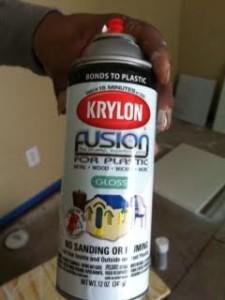
BEFORE
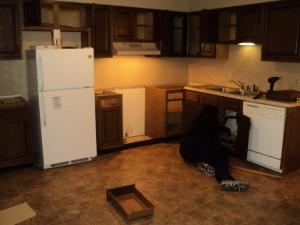
AFTER
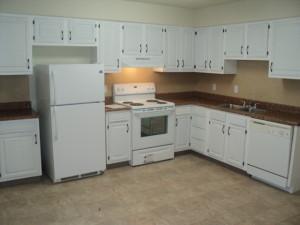
OK – having cleaned up the cabinets, most of the time I change the door-knobs and drawer-pulls, which I get in a big box store around the corner in packages of 10 or 20. Nice looking hardware dresses the space up like you wouldn’t believe; certainly more than good enough for a mid-priced apartment. However, I try not to replace the hinges. While simple accents like knobs can contribute to a dramatic transformation of the space, hinges can be quite difficult to re-align, so unless they are in really bad shape I usually opt for cleaning-up the original hinges and re-hanging them.
Well – that should give you a good idea of the issues involved with cabinetry. Having done all the above you’ll should end-up with a clean-looking kitchen that has a feel of newness about it, without costing you an arm and a leg which is the goal!
COUNTERTOP
How’s someone supposed to feel good about cooking on a countertop with chunks of the finishing laminated surface missing and particle board showing? Talk about cheap and unclean looking. There’s no excuse for this if and there’s no way this will attract a tenant who has options!
Most land-lords understand that this needs to be fixed. However, it is beyond me why anyone would try to save literally a few dollars by re-finishing existing countertops. Please don’t be the worst kind of do-it-yourselfer that there is and try to refinish the existing countertop by gluing a new sheet of laminate on it. Some people do that you know – don’t do it; not when you can buy 6”, 8”, and 12” sections at a local big box store for about $10-$12 per linear foot. You can buy sections with a 45 degree cut on one side with mitered joints pre-cut for you, as well as the hardware to couple sections to create L-shapes. Pay a carpenter a few bucks to do it write – literally, $200 – $300 will pay for this labor…
SINK and FUACET
Once in a while, you’ll walk into a kitchen and see one of those dark brown old as sin sinks, and most of them have rust stains, or even wholes. I once was walking through a unit of a potential acquisition and noticed that I could see the base cabinet from atop the sink – wow! This was one of those old dark brown sinks original to the time of construction about 50 years ago.
Obviously, a functionally obsolescent sink like this needs replaced, but even in the unlikely case that there’s nothing functionally wrong with it, an old brown, yellow, or orange (I’ve seen all of those colors before) sink like that is just ugly – you know what I mean? A tenant with options would no doubt choose your competitor’s kitchen.
As to the cost of replacing the sink you can buy a decent stainless steal 2-bowl sink for around $100 or less at the local big-box store. Sinks are available in 1 or 2-bowl configurations, of which your tenants would prefer the 2-bowl and since there’s only a minimal difference in price I see no reason not to oblige. The size and depth of the bowls varies, but for an apartment anything goes. The sturdiness of a stainless steel sink is a function of the thickness of the steel, which ranges between 18 and 22-gauge – the higher the number the thinner the steel. I would recommend you stick with 20-gauge steel or better; anything thinner is kind of flimsy.
As to faucets, imagine you are walking a potential tenant through your unit. You’ve done everything right and they ask for a rental application. The two of you are standing in the kitchen since the prospect wants to fill out the app right there, and as you are talking she reaches over to turn on the faucet and as she does both of you notice that there’s water coming out from the base of the faucet… You can tell her that this will be fixed all day long, but a damaging seed has been planted. This is not a huge problem and you will expeditiously remedy it, but you should have noticed this before!
A brand I like to use a lot is American Standard for its’ rugged construction which your plumber can pick up at the local distributor, but a good quality or Delta faucet also works well. When I say “good quality” I don’t mean fancy; simple, but sturdy is the name of the game. Don’t buy the cheap plastic stuff!
FLOORING
This might come as a shock to you, but it is not uncommon to find carpet in the kitchen. I’ve noticed this being specifically prevalent in buildings built on a concrete slab foundation before around 1980.
I have a theory as to why this is. Currently, with the advent of very durable and high-quality vinyl as well as floating laminated floor there are a lot of options available for covering concrete. However, a few decades ago there was no laminated floor, and the vinyl floor was rather primitive in design options and not very durable, and yet it was not cheap.
This left ceramic tile, but this was quite pricey to lay and somewhat impractical in most rental units from the stand-point of maintenance. Thus, some landlords and even builders laid exterior grade carpet in the kitchen.
Unfortunately, I’ve never met a tenant who would look at that and get excited – can you blame them? No, and regrettably there is nothing fun about rectifying this item since most of the time the carpet is actually glued to the concrete, which can be quite painful to rip up and will most likely cause chips of concrete to come up with the carpet, in which case prior to being able to lay the finishing surface, your contractor will need to skim the floor with a thin layer of specialized cement to level it. All of this takes time and money – oh well. You can not leave the carpet down in my opinion!
Aside for this, many options can work here, and every investor has a preference of the flooring product for the kitchen. A lot of people like tile – they say it’s easy to clean and is durable. I disagree…
Tile breaks when heavy things are dropped on it – period! I don’t care how good of a job you do leveling the backer-board, spreading the adhesive, or grouting – tile breaks. And when it breaks it needs replaced, which can cause issues. First – you have to get your hands on the right tile product. But, even if you were smart and kept a few extras, the problem is the grout – we talked about this earlier. Grout, even if sealed properly, ages over time, and when it does it changes in color and shade. As such, even if you are able to cut out the broken tile, and even if you have replacement, mixing fresh grout to match the seasoned stuff that’s already there is nearly impossible. In the end, the floor looks funny. I stay away from tile in rental units…
Another type of product that I don’t care for (in any space but especially in the kitchen) is the snap-together floating laminate floor. When properly installed, this floor requires a backing which serves as a moisture barrier. Why – because moisture causes warping of the planks. What is the place where moisture is most likely to exist – the kitchen. Indeed, people spill stuff…
Having said this, my favorite material to use in the kitchens and bathrooms is rolled vinyl. The quality of this product is very good now days, presuming you don’t buy the cheapest stuff out there. As far as color and pattern, there are so many options. They make it so that a pattern that looks like a tile floor, also feels like it because there are indentations in the material consistent with what a real tile floor feels like – it’s amazing and you don’t have to spend a ton.
I buy good quality vinyl for around $10/yard, and with 25 yards covering a huge (15” x 15) kitchen, the cost of vinyl is about $250; most apartment kitchens are not that big! Additional costs are labor and some glue, transition strips for where the vinyl meets carpet, and some seam sealer. Most of the time, I can get the floor done for $750 or so all in, and that’s if the floor needs a lot of prep-work before vinyl can be laid.
But, when finished vinyl looks great and it’s easy to clean up between tenants. When choosing vinyl, make sure that you pick a product that is of neutral color with a matte finish – high-gloss finish tends to show scratches a lot more than a matte finish. By and large, vinyl lasts well unless it is terribly abused.
APPLIANCE PACKAGE
Relative to appliances there can be two separate issues: broken and obsolescent. Appliances, as everything else in the kitchen need to function as intended, and be clean. However, sometimes that’s not enough when we are dealing with appliances, because even something that is clean and functions as well as it did the day it came out of the factory, it can still be very user-unfriendly, which causes big problems in trying to attract good tenants.
For example, you’ve likely seen those ancient 24-inch wide built-in ovens that you couldn’t fit a modern stock pot into. Even if it functions perfectly well, it just doesn’t conform to the expectations of the modern marketplace.
The same can be said about 24-inch wide ranges, and you’ll see a lot of those in apartment buildings from the 60es and 70es. In fact, this size unit is typically referred to as apartment-size unit. Even if they work perfectly well, it is very difficult to see them as desirable and therefore you may choose to replace them.
However, replacing a 24” stove and range hood that are recessed tightly between base cabinets with a wider (30” ) unit will require moving cabinets if there is room, and if not – cutting cabinets. Most of the time this can be accomplished fairly easily, especially if the cabinets will get painted after the fact, but at times this is impossible for one reason or another, in this case the kitchen is obsolete and I’d stay away – there is nothing that can be done to attract a discerning renter.
Another example is refrigerators that are half the size of a standard modern entry-level machine – the rusted, ugly wire shelves are so close together that a gallon of milk does not fit. No one in their right mind would look at those items and think – I can work with this, or this is nice. Certainly, well-qualified tenants in the mid price point would pass on this proposition…
Also, I always try to install dishwashers into all of my kitchens. My experience, as well as my keen sense of the obvious, tells me that in this day and age most people expect there to be a dishwasher in their kitchen. In order to create space for a dishwasher I often need to sacrifice one of the base cabinets adjacent to the sink, which I feel is well worth it. And incidentally, this is another reason why I prefer to paint cabinets – if it becomes necessary to build out the frame of the base unit in order to make things fit and look right, paint does a much better job of masking the differences in wood type and grain than varnish can.
Now – a dishwasher needs plumbing and power, and in terms of power most states require it to be on a dedicated breaker. Incidentally, if there’s not enough power to the unit, and kitchen in specific, to accommodate a dedicated breaker for a dishwasher, this is another example of functional obsolescence which may or may not be feasible to rectify depending on the cost. Thankfully, breaker boxes in most rental units are situated close to the kitchen or in the kitchen since, so you likely won’t have to run and fish 50 feet of wire. But, this is still a job and an expense that you should accommodate in your rehab calculus…
CONCLUSION
Well, this should give you a good birds-eye view on the process of remodeling an apartment kitchen. To summarize, the basic principals are the following:
Stable Passive Cash Flow requires that your apartment is appealing to stable tenants who have options. The kitchen is the one of the spaces in the unit which is most responsible for desirability to tenants. Therefore, when remodeling an apartment kitchen you must create a space that stands above your competition.
Remember, however, that the feel of newness is much more important than actual newness. Unless you are dealing in executive-style units at the top of the market, the goal is always to fix rather than replace – so long as the resulting space is clean, functional, and convenient.
Finally, Stable Passive Cash Flow also requires that your unit is easy to maintain. Therefore, while remodeling an apartment kitchen always keep in mind that the surfaces and amenities you install are sturdy and as easy to fix when break as possible, which out rules some types of materials.
Photo Credit: Hessianizer via Compfight cc

10 Comments